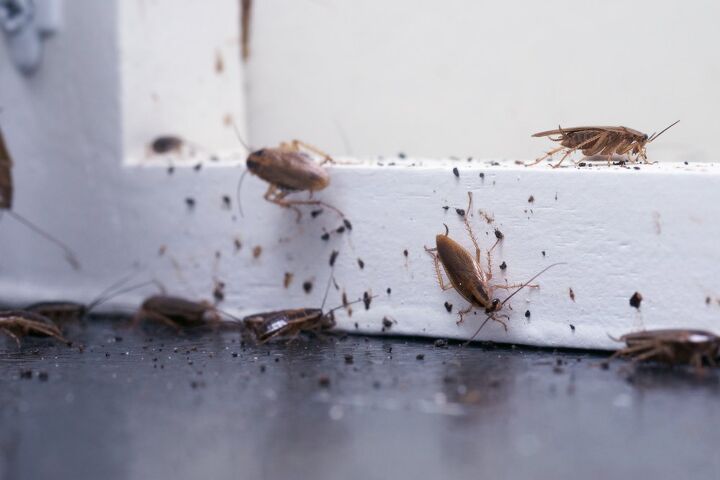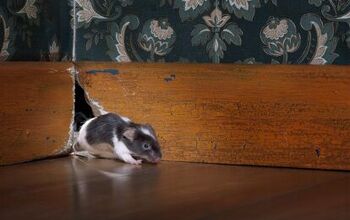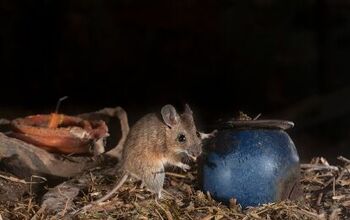What Do Roach Droppings Look Like? (Find Out Now!)

No one wants to have to look for cockroach droppings, but this simple task can go a long way towards preventing infestation and disease. Locating roach feces will help you find out where the cockroaches are congregating, where they’re getting their food and water from, and, thus, give you the upper hand at getting rid of them for good.
Fortunately, roach droppings aren’t too difficult to identify and spotting them is one of the most common forms of roach infestation evidence. Small roaches tend to leave behind brown or black droppings that resemble coarse ground coffee or black pepper. Whereas, larger cockroaches leave behind solid droppings that are shaped like cylinders, with ridges on the side and blunt ends.
Generally speaking, anywhere you locate a large amount of roach droppings can be considered “ground zero” for starting control methods. Continue reading to learn more about identifying roach droppings, where to find them in your home, how to properly dispose of them, and more.
Do You Need Pest Control Services?
Get free, zero-commitment quotes from pro contractors near you.

What Do Roach Droppings Look Like?
The droppings that roaches leave behind can tell you quite a bit about the cockroaches themselves. By analyzing their feces, you can determine the species and size, while ruling out other possible pests to better focus on your extermination efforts. When it comes to identifying roach droppings, consider three primary characteristics:
1. Color
In general, roach droppings have a stark, dark brown hue. The droppings may even appear black, depending on the age of the feces, the diet of the cockroach, and surrounding contaminants.
Unfortunately, dropping color does not vary based on the breed of cockroach. Examining the color of the feces will not do anything to help you determine whether you have a German or American cockroach infestation, for example.
2. Shape and Size
Instead of color, roach species can be narrowed down depending on the size and shape of the droppings. As you might expect, small roaches leave small droppings and larger roaches will leave behind larger droppings around your house.
Small Cockroaches
Small cockroaches all share similar characteristics in their feces, appearing like tiny black flecks scattered around an area. Though, they range in appearance from coarse coffee grains to ground black pepper. Depending on the roach and surface, the droppings may also appear as stains or dark ink. Upon closer inspection, you’ll notice that small roach droppings are round in shape.
Large Cockroaches
For large cockroach species, like the Oriental or American cockroach, their feces look like cylinders. They feature ridges along the sides, from tip to tip, and have rounded ends. The ridges will help you differentiate between roach droppings and mouse or rat droppings, as they are often confused.
While you may need a magnifying glass to see, the presence of ridges indicates roach droppings and not mouse droppings. Mouse droppings, on the other hand, are often slightly larger and typically have short hairs. Being able to tell the difference will help you avoid putting out mouse traps by mistake while your roach infestation keeps growing.
Young Cockroaches
Young, or nymphs, will leave behind distinct droppings, depending on their adult size. Young roaches from a smaller species will leave the tiniest droppings, often called ‘specs.’ Whereas, nymphs from the larger roach species will still leave behind cylindrical, ridged feces. However, they’ll be a lot smaller than the adult droppings, which may be as big as a single grain of rice.
3. Texture
If the roach droppings are not whole, they may look like stains or smears on a surface. Since cockroach feces have marginal water content, they won’t soak into fabric or other materials. Instead, what results is a raised mark. In some cases, like when small droppings look like ink, you may have to inspect more closely:
- For hygiene purposes, make sure you’re wearing rubber or latex gloves.
- Carefully smear the dropping with your finger.
- By doing this, you’ll notice that the dropping is not completely smooth. Instead, it will spread unevenly and have a waxy texture.
If they are mouse or rat droppings instead of roach droppings, they will smear in a wetter, more greasy manner.
Where to Look for Roach Droppings
Cockroaches will leave droppings literally everywhere they go in your home. Obviously, they don’t have a designated bathroom, but there are areas where you’re more likely to find feces. Roaches commonly defecate near their congregation areas, food sources, nesting locations, and anywhere else that they spend most of their time. Why is this important to know?
- Locating the roach nest can help you eliminate the infestation.
- If it’s only one or two roaches and not an entire infestation, knowing their food source can help you cut off the supply. This will cause the cockroaches to either starve or leave your home.
So, where should you look for roach droppings in your home?
Cracks & Crevices
Since cockroaches can be as tiny as ½ inch long, they can easily get into the smallest spots in your home and leave their droppings. Some of these unsuspecting areas include:
- Along the baseboards
- In the corners of any room
- Behind or underneath furniture
- Near the garbage can
- Around electrical outlets and light switches
Any opening or crack in your walls, floors, or a structure, in general, should be checked as well.
Storage Areas
Storage areas and particularly areas that have organic materials, like paper and cardboard boxes, are commonplace to find roach droppings. So, be sure to check your closets, attic, basement, and wardrobes. These locations provide darkness and shelter for cockroaches, and are ideal for avoiding detection from both humans and pets.
When inspecting these areas, make sure you use a flashlight and look deep into the corners. If you have an infestation of small cockroaches, it’s easy to miss their droppings in such dark spots where they can be mistaken for dust or other debris.
Bathrooms
It’s common for roaches to gain entry to your home via leaky pipes, leading to a full-on cockroach infestation in your bathroom. Bathrooms are quiet, warm, moist, and provide a place for roaches to feed on soap, toilet paper, and even hair. Look everywhere in your bathroom for cockroach droppings, including around the base of your toilet, near drain pipes, behind the trash can, and inside cabinets and cupboards.
Laundry Room
Like your bathrooms, your laundry room is a warm and moist place thanks to the washer and dryer. In contrast to the rest of your home, laundry rooms also typically see much less foot traffic. All of these conditions make for an ideal congregating spot for cockroaches. In your laundry room, look out for droppings in any of the following places:
- Inside cabinets and cupboards and/or on shelving.
- Near bottles of detergent and other products that are seldom used or moved.
- Under and behind your washing machine and dryer.
Kitchen
Overall, your kitchen is a prime location to find roach droppings and cockroaches in general. They’ll typically collect near a food supply, so inspect your cabinets, shelves, drawers, and behind and/or under your fridge. Roaches love to hide, so don’t forget to look in all the nooks and crannies in your kitchen space.
Do Roach Droppings Have an Odor?
Yes, cockroach droppings do, in fact, have a tell-tale smell. However, in most cases, you need a large quantity before the odor is detected. Generally speaking, cockroach feces gives off an odor that is often described as moldy, musty, oily, and ‘similar to mothballs.’
However, the scent that your nose smells is only half of the story. Roach droppings contain an aggregation pheromone that serves as a summoning beach to other cockroaches, drawing them to gather. It provides a trail for other cockroaches to follow and find each other. This means that the smell of roach droppings isn’t just unpleasant, but it’s also making your infestation worse.
Do You Need Pest Control Services?
Get free, zero-commitment quotes from pro contractors near you.

How to Clean Roach Droppings
Disposing of roach droppings is much more than simply sweeping them away without care. Since roach feces contains dangerous contaminants, it’s crucial that you approach clean-up appropriately. For starters, make sure you take steps to protect yourself as the droppings are most dangerous upon inhalation and skin contact. So, wear gloves and face mask, keep children away, and ventilate the area if you or another occupant of the home has asthma.
Loose droppings can be vacuumed up from the surface using a vacuum with a HEPA filter, which will help reduce airborne contaminants. Afterwards, be sure to dispose of the filter’s contents immediately, while still maintaining proper sanitization efforts.
Then, use hot, soapy water to wipe down surfaces and remove any existing smears or stains. This will not only eliminate the unsightly roach droppings, but also the musty and roach-attracting odor that comes with them. If you the soapy water isn’t effective at removing stains, use a diluted citrus-based cleanser. Finally, clean any items that came in contact with droppings, whether it be your furniture, clothing, mattresses, or anything else.
Pro Tip: If you notice that the musty smell is lingering after clean-up, use baking soda to neutralize the odor.

Jessica considers herself a home improvement and design enthusiast. She grew up surrounded by constant home improvement projects and owes most of what she knows to helping her dad renovate her childhood home. Being a Los Angeles resident, Jessica spends a lot of her time looking for her next DIY project and sharing her love for home design.
More by Jessica Stone



























